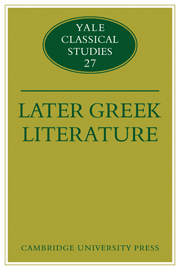Book contents
- Frontmatter
- Contents
- Introduction
- Theme, structure and narrative in Chariton
- The importance of sophists
- Lucian: a sophist's sophist
- The mendacity of Kalasiris and the narrative strategy of Heliodoros' Aithiopika
- The Emperor Julian on his predecessors
- Greek translations of Latin literature in the fourth century A.D.
- The empress and the poet: paganism and politics at the court of Theodosius II
- Pastiche, pleasantry, prudish eroticism: the letters of ‘Aristaenetus’
- The date and purpose of the Philopatris
Pastiche, pleasantry, prudish eroticism: the letters of ‘Aristaenetus’
Published online by Cambridge University Press: 06 December 2010
- Frontmatter
- Contents
- Introduction
- Theme, structure and narrative in Chariton
- The importance of sophists
- Lucian: a sophist's sophist
- The mendacity of Kalasiris and the narrative strategy of Heliodoros' Aithiopika
- The Emperor Julian on his predecessors
- Greek translations of Latin literature in the fourth century A.D.
- The empress and the poet: paganism and politics at the court of Theodosius II
- Pastiche, pleasantry, prudish eroticism: the letters of ‘Aristaenetus’
- The date and purpose of the Philopatris
Summary
Più volte Amor m'avea già detto: ‘Scrivi, Scrivi quel che vedesti in lettre d'oro.’
With the substitution of some less precious metal for Petrarch's gold, these lines, which open his 93rd sonnet, would provide an appropriate motto for the curious collection of fifty fictitious letters contained in a single Greek manuscript copied in the south of Italy about a.d. 1200 and now preserved (cod. phil. graec. 310) in the Austrian National Library at Vienna. This manuscript twice identifies its epistolographer as one Aristaenetus, but in fact the author's name is as uncertain as his birthplace and the dates of his career.
Merrier was the first scholar to observe that the first letter in the collection was imagined by its author to have been sent by one ʾΑρισταίνετος to one ϕιλόκαλος, and to suggest in consequence that ‘forsitan nomen inscriptum primae epistolae translatum ad auctorem huius rhapsodiae.’ The genre of imaginative epistolography to which this rhapsodia belongs appears to have been subject to a number of rules about such things as the exploitation of earlier writers, the choice and use of themes, and attitudes to sexual morality. One of the rules concerned the naming of the fictitious correspondents. Three kinds of name were tolerated. Real names from the historical and literary past were affixed to some of the letters in order to add a spurious touch of verisimilitude to the nostalgic evocation of a more classical past.
- Type
- Chapter
- Information
- Later Greek Literature , pp. 291 - 320Publisher: Cambridge University PressPrint publication year: 1982



